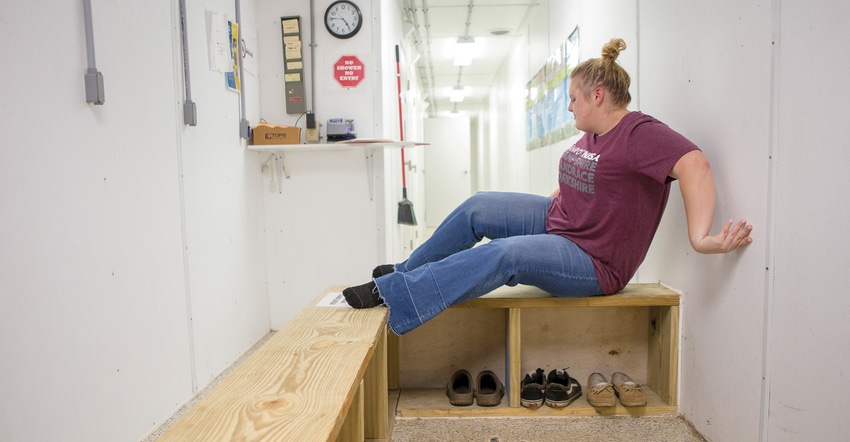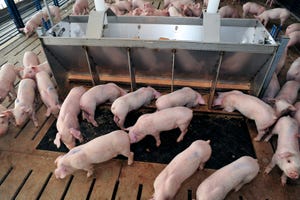Danish entry systems: What steps are we skipping?
Schuft compares performing a biosecure entry to choreographing a dance.

Biosecurity is one of the best ways to keep pigs healthy and maintain business continuity within a pork production system. However, before employees reach the entry of the barn, there are three tiers to biosecurity that every site should consider.
According to University of Minnesota Associate Extension Professor Abby Schuft, those three tiers are:
Conceptual biosecurity: adapting biosecurity needs to each farm’s specific circumstances.
Structural biosecurity: tangible and fixed cost features of production.
Operational biosecurity: relies on the behavior of people.
Operational is the least dependable of the three tiers, Schuft says.
“It's the human aspect of biosecurity and this is the tier of biosecurity where you can fix and mitigate the liabilities that you've already identified through your conceptual or your structural biosecurity through an audit, through training, through constructive criticism,” Schuft says. “However, this tier of operational biosecurity is the most unreliable because it does rely on human behavior.”
Schuft and her team set out to examine how biosecurity protocols are being taught to employees and visitors as well as the practicality and efficacy of those biosecurity steps. In a recent study, the team evaluated three education methods to teach protocols for a biosecure barn entry and exit by evaluating the number of errors, length of time to complete and how the education method affected compliance over time.
Three mock biosecure entryways were set up in a laboratory space at the University of Minnesota, with each entry having its own assigned protocols:
Protocol one was to simply come in, sign a visitor's book, remove any personal outerwear or items, and do something with their phone.
In addition to those steps, protocol two introduced a clean/dirty line of separation, a piece of tape on the floor. Participants were then asked to remove their footwear, step across the line of separation and put on barn specific boots. Finally, they were asked to apply hand sanitizer before entering the barn area.
Protocol three was very similar to protocol two, except the line of separation included the physical barrier of a bench. Participants were also asked to put on a lab coat to simulate barn specific coveralls and then wash hands before entering the barn.
Once the participants were in the barn they were given three simple tasks such as putting together a 24-piece puzzle, reading a weather gauge and taking some data.
“We were trying to maybe distract them a little bit and simulate work that they would be doing in the barn before they had to come back and exit the biosecure room in the opposite fashion of where they entered,” Schuft says.
All participants enlisted for the project were recruited from within the University of Minnesota. Participants included students, faculty and staff from the agriculture related departments, but with varying experience with biosecurity.
“Some of them were very naïve. Some were student workers; some were students that worked on a farm. Some of us were really academically smart about biosecurity, but the act of doing it physically could have been a little bit of a challenge,” Schuft says.
The treatment variables were to view the first round or initial visit and then four to eight weeks later when the participants visited again. Instructions were offered via written material, auditory or visually. However, during the second visit, participants did not get any instructions again, and were expected to rely on what they were taught during the first visit.
Schuft and her team observed how long it took participants to enter the room and how long it took them to leave, as well as how many errors they had going in and coming out. According to their analysis, the only variable that contributed to entry errors was the time between visits.
“There were one and a half times more errors on their second visit than there were on their first visit when they entered the biosecure entryway,” Schuft says. “As with respect to when they were leaving the farm, there were 1.2 times more errors in round two than there were in round one.”
As for exit errors by protocol, the more protocol steps the more room for error. During protocol two, the six steps definitely had more errors than the three steps in protocol one, and even more errors occurred in protocol three than the other two.
Common errors included not removing their outerwear or other items such as watches, hats, keys or sweatshirts. “The instructions were to just remove your outerwear or personal items you would not wear into a barn,” Schuft says. “So, the practical aspect of this is if you don't want them wearing their sweatshirt into the barn, you're going to likely have to encourage and specify, do not wear outside sweatshirts.”
In protocol three, where participants were asked to put on the lab coat, 63% of them did not fully button the coat. While it was not instructed to do so, Schuft says this highlights the need to spell out all biosecurity steps with a protocol.
Several of the participants did not close the entry and barn doors. “There was an 18% error rate among all three protocols, with both rounds coming and going, that that exterior door was not closed and a 23% error rate for the door of the entryway to the barn not being closed,” Schuft says. “Most of those errors happened in protocol three, so that leads to the question, was that a structural biosecurity problem that probably could have been fixed because those doors were harder to close, they didn't actually latch, or were they just so frustrated with the number of steps that they had to complete that they were done and they were over it and they just didn't do it.”
The team also observed far more errors with the line of separation rather than the physical barrier of a bench, Schuft says something she fully expected. She relates performing a biosecure entry to “choreographing a dance.”
“What I'm physically capable of is going to be very different than what a 24-year-old new veterinarian can probably physically do compared to the 72-year-old farmer who's still hard at it,” Schuft says. “And part of that personal choreography for being able to properly enter and exit a biosecure entry is making sure your feet are where they need to be at the appropriate times.”
A notable observation was several participants needed some sort of form of support when removing shoes and putting on shoes. In fact, 77% of all entries and exits put their hand on the wall at some point to slip their feet out of their footwear, whether it was their street footwear or their barn specific footwear.
“So that tells you a lot, have something in your entries and exits clean and dirty that people can use to support that,” Schuft says. “And that also needs to be cleaned as part of your protocol in those spaces.”
As for positive biosecurity protocols, every participant signed the visitor's logbook and did something with their phones. In fact, more than half left their phone in the entryway or didn't bring it in the barn with them. 32% of them didn't even bring their phone into the entry or barn and left it on the registration table. Thirty-five percent of the participants left their phone in the biosecure entry where an additional 15% of them put it in a Ziploc bag and left it in the entry, and 18% of the participants did put it in a Ziploc bag, but then carried it with them on their person. Also 100% of footwear was removed and no footwear crossed the bench or the line of separation.
As for time of entry and exit, those that had more experience with biosecurity on farms took less time than those who were first introduced to the project. Schuft says this quantifies the fact that the first time a new worker, veterinarian or service provider visits a farm premise, it will take them longer to go through biosecure protocols expected.
She also notes the results show that the number of steps required in a biosecure protocol and the length of time between visits are more effective predictors of biosecure entry and exit errors than the method used to teach the protocols. However, the team recognizes that each participant has a different learning style, and that should be considered when training on site.
“And compliance changes over time,” Schuft says. “We know compliance is our challenge. Make sure you're constantly training, you're constantly reminding, you're auditing, you're training.”
Schuft recently presented this research and more during the Allen D. Leman Swine Conference in St. Paul.
About the Author(s)
You May Also Like





